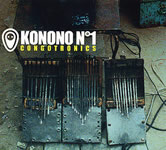|
|
 |
Dusted Reviews
Artist: Konono N°1 Album: Congotronics Label: Crammed Discs Review date: Feb. 25, 2005 |

|
|
|
 |
Congotronics showcases the music of Konono N°1, musicians of the Bazombo ethnic and linguistic subdivision. Stuck on the Congo side of the artificial Congolese/Angolan border, Konono N°1 exacts a blissful, spiritual revenge on the harsh poverty and war that plagues the region, armed with the artful reuse of found magnets, carved wooden microphones, brake-drum snares, and indigenous instruments like the likembé (not unlike the thumb piano).
Konono N°1 amplifies their pulsing trance music to the point of distortion, a brighter, punchier variety than the regionally-preferred “buzz” created by West African club owners when they intentionally plunge kitchen knives into the cone of a brand new jukebox speaker. The sounds of the likembé dominate, producing a complex ostinato melody in such flowing unison that it’s not always apparent there are three likembé players; solo, accompanist, and bass. The disciplined likembé work, at times, shows hints of the same cooperative spirit and rhythmic intricacy as batå groups of the Yoruba/Afro-Cuban tradition. Almost classically psychedelic at times, with the overdriven saturation of too much light, motion and volume applied to every aspect of the music, this ensemble, led by solo likembé player Mawangu Mingiedi, represents the best of gritty, pre-funk groove music, Day-Glo popcorn cooking in gasoline, rattling like a machine gun. Derived from traditional Bazombo music, the trance-inducing aspects of the music find their way to the top of the mix, despite the sonic marinade of McGyver’d electronics.
The sharp rattle of the hand-tooled snare drum permeates throughout, relentlessly and flawlessly maintaining the semi-ancient rhythmic cornerstone of clavé. Absent the improvised electronics, Congotronics could still fascinate as a tight, 50-minute argument on the sizable contribution the Kongo people made to rumba, often obfuscated by its mad popularity as a Cuban export. This is the Afro in Afro-Cuban, as well as Afro-Brazillian, and maybe Afro-everything. The hard rhythmic backbone is sometimes a ringer for Cuban guaguanco at its fastest, as in the opening “Lufuala Ndonga,” and yambu when things relax slightly on cuts like “Kule Kule.” Other elements hark forward to other descendant styles, such as the omnipresent whistle heard in popular samba music, and the martial snare work heard in Cuban comparsa.
In addition to some of the rhythmic similarities, of which this music is clearly the forebear, the communal vibe of samba schools and rumba groups is present as well: if Mingiedi is the musical force behind Konono N°1, actual leadership may be the province of Buaku Ningulu, their “president,” as indicated in the liner notes. But everyone sings, making it a team affair, and the twelve musicians build a singular voice and groove on every track.
The bright pentatonic glee produced by the likembé players broadcasts its message while forecasting a parallel evolution, that of the electric guitar sounds of hambone-era American blues. The rigid call-and-response between vocalist and singers, paired with the subtly shifting dynamics, however, reinforce the African element, a technicolor stamp that shouts “we were here first, and the broken down rubble of colonialism has become our megaphone.” Konono N°1 plays music that defies racist classifications like “tribal” or “primitive,” and it’s not a quaint version of something American or European. Congotronics cooks like a machine itself, churning away, throwing orange and red sparks about the room, but more sophisticated than machinery, electronics and technology in general: This music is powered by spirits, and channeled through Konono N°1’s sound system, borne of the junkyard and transmitting aural fire.
By Andy Freivogel
|







